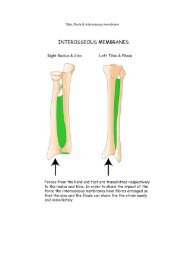GSM 11.11 version 6.2.0 - TTFN Smart card pages
GSM 11.11 version 6.2.0 - TTFN Smart card pages
GSM 11.11 version 6.2.0 - TTFN Smart card pages
- No tags were found...
You also want an ePaper? Increase the reach of your titles
YUMPU automatically turns print PDFs into web optimized ePapers that Google loves.
(<strong>GSM</strong> <strong>11.11</strong> <strong>version</strong> <strong>6.2.0</strong> Release 1997)91TS 100 977 V<strong>6.2.0</strong> (1999-05)NOTE:The identification of the data within an EF to be acted upon by the above procedures is specified withinthe command. For the procedures in subclauses 11.1.1 and 11.1.2 this data may have been previouslyidentified using a SEEK command, e.g. searching for an alphanumeric pattern.11.2 SIM management proceduresPhase 2 MEs shall support all SIMs which comply with the mandatory requirements of Phase 1, even if these SIMs donot comply with all the mandatory requirements of Phase 2. Furthermore, Phase 2 MEs shall take care of potentialincompatibilities with Phase 1 SIMs which could arise through use of inappropriate commands or misinterpretation ofresponse data. Particular note should be taken of making a false interpretation of RFU bytes in a Phase 1 SIM havingcontradictory meaning in Phase 2; e.g. indication of EF invalidation state.11.2.1 SIM initializationAfter SIM activation (see subclause 4.3.2), the ME selects the Dedicated File DF <strong>GSM</strong> and optionally attempts to selectEF ECC . If EF ECC is available, the ME requests the emergency call codes.The ME requests the Extended Language Preference. The ME only requests the Language Preference (EF LP ) if at leastone of the following conditions holds:- EF ELP is not available;- EF ELP does not contain an entry corresponding to a language specified in ISO 639[30];- the ME does not support any of the languages in EF ELP .If both EFs are not available or none of the languages in the EFs is supported then the ME selects a default language. Itthen runs the CHV1 verification procedure.If the CHV1 verification procedure is performed successfully, the ME then runs the SIM Phase request procedure.For a SIM requiring PROFILE DOWNLOAD, then the ME shall perform the PROFILE DOWNLOAD procedure inaccordance with <strong>GSM</strong> 11.14 [27]. When BDN is enabled on a SIM, the PROFILE DOWNLOAD procedure is used toindicate to the SIM whether the ME supports the "Call Control by SIM" facility. If so, then the SIM is able to allow theREHABILITATE command to rehabilitate EF IMSI and EF LOCI .If the ME detects a SIM of Phase 1, it shall omit the following procedures relating to FDN and continue with theAdministrative Information request. The ME may omit procedures not defined in Phase 1 such as HPLMN SearchPeriod request.For a SIM of Phase 2 or greater, <strong>GSM</strong> operation shall only start if one of the two following conditions is fulfilled:- if EF IMSI and EF LOCI are not invalidated, the <strong>GSM</strong> operation shall start immediately;- if EF IMSI and EF LOCI are invalidated, the ME rehabilitates these two EFs.MEs without FDN capability but with Call control by SIM facility shall not rehabilitate EF IMSI and/or EF LOCI ifFDN is enabled in the SIM and therefore have no access to these EFs. <strong>GSM</strong> operation will therefore beprohibited;MEs without FDN capability and without Call control by SIM facility shall not rehabilitate EF IMSI and/or EF LOCIand therefore have no access to these EFs. <strong>GSM</strong> operation will therefore be prohibited.It is these mechanisms which are used for control of services n°3 and n°31 by the use of SIMs for these serviceswhich always invalidate these two EFs at least before the next command following selection of either EF.NOTE:When FDN and BDN are both enabled, and if the ME supports FDN but does not support the Call controlby SIM facility, the rehabilitation of EF IMSI and EF LOCI will not be successful because of a restrictionmechanism of the REHABILITATE command linked to the BDN feature.When EF IMSI and EF LOCI are successfully rehabilitated, if the FDN capability procedure indicates that:i) FDN is allocated and activated in the SIM; and FDN is set "enabled", i.e. ADN "invalidated" or not activated;and the ME supports FDN;ETSI








